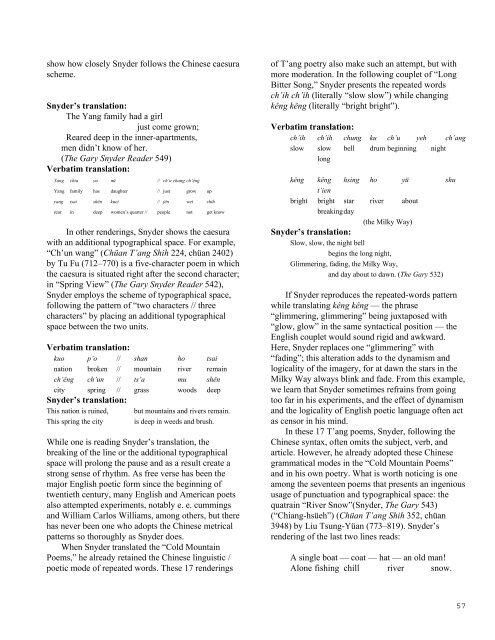their - The University of Texas at Dallas
their - The University of Texas at Dallas
their - The University of Texas at Dallas
Create successful ePaper yourself
Turn your PDF publications into a flip-book with our unique Google optimized e-Paper software.
show how closely Snyder follows the Chinese caesura<br />
scheme.<br />
Snyder’s transl<strong>at</strong>ion:<br />
<strong>The</strong> Yang family had a girl<br />
just come grown;<br />
Reared deep in the inner-apartments,<br />
men didn’t know <strong>of</strong> her.<br />
(<strong>The</strong> Gary Snyder Reader 549)<br />
Verb<strong>at</strong>im transl<strong>at</strong>ion:<br />
Yang chia yu nü // ch’u chang ch’êng<br />
Yang family has daughter // just grow up<br />
yang tsai shên kuei // jên wei shih<br />
rear in deep women’s quarter // people not get know<br />
In other renderings, Snyder shows the caesura<br />
with an additional typographical space. For example,<br />
“Ch’un wang” (Chüan T’ang Shih 224, chüan 2402)<br />
by Tu Fu (712–770) is a five-character poem in which<br />
the caesura is situ<strong>at</strong>ed right after the second character;<br />
in “Spring View” (<strong>The</strong> Gary Snyder Reader 542),<br />
Snyder employs the scheme <strong>of</strong> typographical space,<br />
following the p<strong>at</strong>tern <strong>of</strong> “two characters // three<br />
characters” by placing an additional typographical<br />
space between the two units.<br />
Verb<strong>at</strong>im transl<strong>at</strong>ion:<br />
kuo p’o // shan ho tsai<br />
n<strong>at</strong>ion broken // mountain river remain<br />
ch’êng ch’un // ts’a mu shên<br />
city spring // grass woods deep<br />
Snyder’s transl<strong>at</strong>ion:<br />
This n<strong>at</strong>ion is ruined, but mountains and rivers remain.<br />
This spring the city is deep in weeds and brush.<br />
While one is reading Snyder’s transl<strong>at</strong>ion, the<br />
breaking <strong>of</strong> the line or the additional typographical<br />
space will prolong the pause and as a result cre<strong>at</strong>e a<br />
strong sense <strong>of</strong> rhythm. As free verse has been the<br />
major English poetic form since the beginning <strong>of</strong><br />
twentieth century, many English and American poets<br />
also <strong>at</strong>tempted experiments, notably e. e. cummings<br />
and William Carlos Williams, among others, but there<br />
has never been one who adopts the Chinese metrical<br />
p<strong>at</strong>terns so thoroughly as Snyder does.<br />
When Snyder transl<strong>at</strong>ed the “Cold Mountain<br />
Poems,” he already retained the Chinese linguistic /<br />
poetic mode <strong>of</strong> repe<strong>at</strong>ed words. <strong>The</strong>se 17 renderings<br />
<strong>of</strong> T’ang poetry also make such an <strong>at</strong>tempt, but with<br />
more moder<strong>at</strong>ion. In the following couplet <strong>of</strong> “Long<br />
Bitter Song,” Snyder presents the repe<strong>at</strong>ed words<br />
ch’ih ch’ih (literally “slow slow”) while changing<br />
kêng kêng (literally “bright bright”).<br />
Verb<strong>at</strong>im transl<strong>at</strong>ion:<br />
ch’ih ch’ih chung ku ch’u yeh ch’ang<br />
slow slow bell drum beginning night<br />
long<br />
kêng kêng hsing ho yü shu<br />
t’ien<br />
bright bright star river about<br />
breaking day<br />
(the Milky Way)<br />
Snyder’s transl<strong>at</strong>ion:<br />
Slow, slow, the night bell<br />
begins the long night,<br />
Glimmering, fading, the Milky Way,<br />
and day about to dawn. (<strong>The</strong> Gary 532)<br />
If Snyder reproduces the repe<strong>at</strong>ed-words p<strong>at</strong>tern<br />
while transl<strong>at</strong>ing kêng kêng — the phrase<br />
“glimmering, glimmering” being juxtaposed with<br />
“glow, glow” in the same syntactical position — the<br />
English couplet would sound rigid and awkward.<br />
Here, Snyder replaces one “glimmering” with<br />
“fading”; this alter<strong>at</strong>ion adds to the dynamism and<br />
logicality <strong>of</strong> the imagery, for <strong>at</strong> dawn the stars in the<br />
Milky Way always blink and fade. From this example,<br />
we learn th<strong>at</strong> Snyder sometimes refrains from going<br />
too far in his experiments, and the effect <strong>of</strong> dynamism<br />
and the logicality <strong>of</strong> English poetic language <strong>of</strong>ten act<br />
as censor in his mind.<br />
In these 17 T’ang poems, Snyder, following the<br />
Chinese syntax, <strong>of</strong>ten omits the subject, verb, and<br />
article. However, he already adopted these Chinese<br />
gramm<strong>at</strong>ical modes in the “Cold Mountain Poems”<br />
and in his own poetry. Wh<strong>at</strong> is worth noticing is one<br />
among the seventeen poems th<strong>at</strong> presents an ingenious<br />
usage <strong>of</strong> punctu<strong>at</strong>ion and typographical space: the<br />
qu<strong>at</strong>rain “River Snow”(Snyder, <strong>The</strong> Gary 543)<br />
(“Chiang-hsüeh”) (Chüan T’ang Shih 352, chüan<br />
3948) by Liu Tsung-Yüan (773–819). Snyder’s<br />
rendering <strong>of</strong> the last two lines reads:<br />
A single bo<strong>at</strong> — co<strong>at</strong> — h<strong>at</strong> — an old man!<br />
Alone fishing chill river snow.<br />
57

















